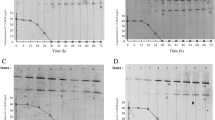Abstract
The natural transformation of Acinetobacter calcoaceticus BD413 (trp E27) was characterized with respect to features that might be important for a possible gene transfer by extracellular DNA in natural environments. Transformation of competent cells with chromosomal DNA (marker trp +) occurred in aqueous solutions of single divalent cations. Uptake of DNA into the DNase I-resistant state but not the binding of DNA to cells was strongly stimulated by divalent cations. An increase of transformation of nearly 3 orders of magnitude was obtained as a response to the presence of 0.25 mM Ca2+. With CaCl2 solutions the transformation frequencies approached the highest values obtained under standard broth conditions, followed by MnCl2 and MgCl2. It is concluded that transformation requires divalent cations. DNA competition experiments showed that A. calcoaceticus does not discriminate between homologous and heterologous DNA. Furthermore, circular plasmid DNA competed with chromosomal DNA fragments and vice versa. The equally efficient transformation with plasmid pKT210 isolated from A. calcoaceticus or Escherichia coli indicated absence of DNA restriction in transformation. High efficiency plasmid transformation was obtained in samples of non-sterile natural groundwater and in non-sterile extracts of fresh and air-dried soil. Heat-treatment (10 min, 80°C) of the non-sterile liquid samples increased transformation only in the dried soil extract, probably by inactivation of DNases. The results presented suggest that competent cells of A. calcoaceticus can take up free high molecular weight DNA including plasmids of any source in natural environments such as soil, sediment or groundwater.
Similar content being viewed by others
References
Aardema BW, Lorenz MG, Krumbein WE (1983) Protection of sediment-adsorbed transforming DNA against enzymatic inactivation. Appl Environ Microbiol 46: 417–420
Bergan T, Vaksvik AK (1983) Taxonomic implications of quantitative transformation in A. calcoaceticus. Zentralbl Bakt Hyg, I. Abt Orig A 254: 214–228
Birnboim HC, Doly J (1979) A rapid alkaline extraction procedure for screening recombinant plasmid DNA. Nucleic Acids Res 7: 1513–1523
Carlson CA, Pierson LS, Rosen JJ, Ingraham JL (1983) Pseudomonas stutzeri and related species undergo natural transformation. J Bacteriol 153: 93–99
Carter DM, Radding CM (1971) The rate of exonuclease and β-protein of phage lambda in genetic recombination. II. Substrate specificity and the mode of action of lambda exonuclease. J Biol Chem 246: 2502–2510
Cruze JA, Singer JT, Finnerty WR (1979) Conditions for quantitative transformation in Acinetobacter calcoaceticus. Curr Microbiol 3: 129–132
Davis RW, Botstein D, Roth JR (1980) Advanced bacterial genetics. Cold Spring Harbor Laboratory, Cold Spring Harbor, USA, p 201
Doran JL, Page WJ (1983) Heat sensitivity of Azotobacter vinelandii genetic transformation. J Bacteriol 155: 159–168
Gabor M, Hotchkiss RD (1966) Manifestation of linear organization in molecules of pneumococcal transforming DNA. Proc Natl Acad Sci USA 56: 1441–1448
Garcia E, Lopez P, Urena TP, Espinosa M (1978) Early stages in Bacillus subtilis transformation: association between homologous DNA and surface structures. J Bacteriol 135: 731–740
Greaves MP, Wilson MJ (1970) The degradation of nucleic acids and montmorillonite-nucleic-acid complexes by soil microorganisms. Soil Biol Biochem 2: 257–268
Juni E (1972) Interspecies transformation of Acinetobacter: genetic evidence for a ubiquitous genus. J Bacteriol 112: 917–931
Juni E, Janik A (1969) Transformation of Acinetobacter calcoaceticus (Bacterium anitratum). J Bacteriol 98: 281–288
Kammen HO, Wojnar RJ, Canellakis ES (1966) Transformation in Bacillus subtilis: II. The development and maintenance of the competent state. Biochim Biophys Acta 123: 56–65
Lorenz MG, Aardema BW, Krumbein WE (1981) Interaction of marine sediment with DNA and DNA availability to nucleases. Mar Biol 64: 225–230
Lorenz MG, Aardema BW, Wackernagel W (1988) Highly efficient genetic transformation of Bacillus subtilis attached to sand grains. J Ger Microbiol 134: 107–112
Lorenz MG, Gerjets D, Wackernagel W (1991) Release of transforming plasmid and chromosomal DNA from two cultured soil bacteria. Arch Microbiol 156: 319–326
Lorenz MG, Wackernagel W (1987) Adsorption of DNA to sand and variable degradation rates of adsorbed DNA. Appl Environ Microbiol 53: 2948–2952
Lorenz MG, Wackernagel W (1988) Impact of mineral surfaces on gene transfer by transformation in natural bacterial environments. In: Klingmüller W (ed) Risk assessment for deliberate releases. Springer, Berlin Heidelberg New York, pp. 110–119
Lorenz MG, Wackernagel W (1990) Natural genetic transformation of Pseudomonas stutzeri by sand-adsorbed DNA. Arch Microbiol 154: 380–385
Lorenz MG, Wackernagel W (1991) High frequency of natural genetic transformation of Pseudomonas stutzeri in soil extract suplemented with a carbon/energy and phosphorus source. Appl Environ Microbiol 57: 1246–1251
Marmur J (1961) A procedure for isolation of deoxyribonucleic acid from microorganisms. J Mol Biol 3: 208–218
Paul JH, DeFlaun MF, Jeffrey WH (1988) Mechanisms of DNA utilization by estuarine microbial populations. Appl Environ Microbiol 54: 1682–1688
Paul JH, Frischer ME, Thurmond JM (1991) Gene transfer in marine water column and sediment microcosms by natural plasmid transformation. Appl Environ Microbiol 57: 1509–1515
Paul JH, Jeffrey WH, DeFlaun MF (1987) Dynamics of extracellular DNA in the marine environment. Appl Environ Microbiol 53: 170–179
Paul JH, Carlson DJ (1984) Genetic material in the marine environment: implication for bacterial DNA. Limnol Oceanogr 29: 1091–1097
Romanowski G, Lorenz MG, Wackernagel W (1991) Adsorption of plasmid DNA to mineral surfaces and protection against DNase I. Appl Environ Microbiol 57: 1062–1069
Singer JT, vanTuijl JJ, Finnerty W (1986) Transformation and mobilization of cloning vectors in Acinetobacter spp. J Bacteriol 165: 301–303
Smith HO, Danner DB, Deich RA (1981) Genetic transformation. Ann Rev Biochem 50: 41–68
Stewart GJ (1989) The mechanism of natural transformation. In: Levy SB, Miller RV (eds) Gene transfer in the environment. McGraw-Hill, New York, pp 139–164
Stewart GJ, Sinigalliano CD (1990) Detection of horizontal gene transfer by natural transformation in native and introduced species of bacteria in marine and synthetic sediments. Appl Environ Microbiol 56: 1818–1824
Stotzky G, Babich H (1986) Survival of, and genetic transfer by, genetically engineered bacteria in natural environments. Adv Appl Microbiol 31: 93–138
Author information
Authors and Affiliations
Rights and permissions
About this article
Cite this article
Lorenz, M.G., Reipschläger, K. & Wackernagel, W. Plasmid transformation of naturally competent Acinetobacter calcoaceticus in non-sterile soil extract and groundwater. Arch. Microbiol. 157, 355–360 (1992). https://doi.org/10.1007/BF00248681
Received:
Accepted:
Issue Date:
DOI: https://doi.org/10.1007/BF00248681




